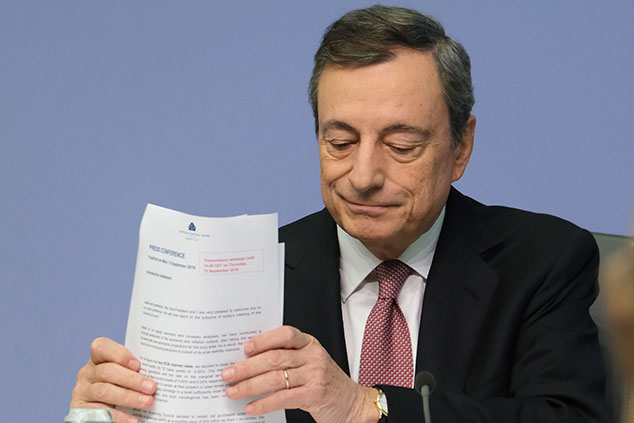
It’s probably too early to tell. But he certainly pulled out the biggest bazooka he could find in this, his second-last monetary policy meeting as boss of the European Central Bank (ECB), before he hands over to Christine Lagarde.
So what’s his legacy?
First, as expected, he cut the eurozone interest rate from negative 0.4% to negative 0.5%. That’s a record low.
The ECB is also introducing a “tiering system” to try to insulate the banking sector against the impact of negative rates. This has already been done in Japan, Denmark and Switzerland, which also have negative rates. On the banking front, there will also be a package of cheap loans.
The ECB will also restart quantitative easing (QE). From November, it will buy €20bn worth of bonds a month.
That sounds like it was less than the market had expected. However, the key point is that Draghi didn’t put an end date on this. In other words, it’ll carry on “for as long as necessary to reinforce the accommodative impact of… policy rates, and to end shortly before” the main ECB rate starts rising.
That means, in effect, “QE Infinity”. Or at least, it sort-of does. The ECB can buy no more than 33% of any government’s outstanding debt, and it didn’t change the limits today. However, it’s worth noting that Draghi once again told governments that fiscal policy (ie, government spending) was the real way out of the eurozone’s economic malaise. “Now is the time for fiscal policy to take charge.”
If governments are issuing a lot more debt, maybe the issue of a ceiling on the amount the ECB can buy at the current rate won’t end up being a problem.
Overall, it certainly seems to be on the “dovish” side. What’s interesting so far (and we’ll have more on this tomorrow) has been the market reaction.
German bund yields at first plunged (ie, bond prices went up) as investors anticipated a lot more buying. They then rose (ie, bond prices fell) as investors apparently had second thoughts.
Some argued that this is because the ECB can’t actually do QE infinity if the 33% limit is still there. I’m not so sure. My own view is that this is the result of investors becoming more optimistic that the ECB is determined to ensure the region avoids a deflationary denouement. It’s hard to justify the German bund with a negative yield if the economy is going to start growing again.
Maybe I’m reading too much into it. We’ll see how the market shakes out for the rest of the day.
But in all, this was more dovish than expected, and if nothing else, it puts more pressure on the Federal Reserve, America’s central bank, to loosen policy too. Which of course, markets are very keen on.